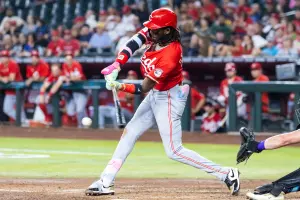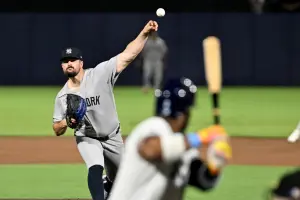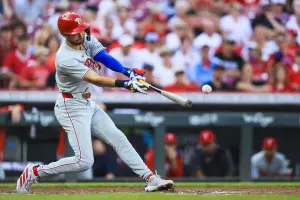
(*) F/F SPOTLIGHT: Miguel Sanó
“Patience is not an absence of action; rather it is 'timing'—it waits on the right time to act.”
- Fulton J. Sheen
Fulton Sheen was a Catholic archbishop, and his advice was probably not intended for baseball players. But it could have been. And in the case of Minnesota Twins slugger Miguel Sanó, Sheen’s word should be taken to heart. Because when Sanó applies patience, and its brother discernment, he shows fearsome power hitter and sky-high upside.
When he doesn’t, he’s more the hacker with occasionally impressive power but limited upside.
A BaseballHQ.com subscription unlocks articles like these all season—and off-season—long. Get the edge in your league! Subscribe to BaseballHQ.com.
Background/History
Miguel Sanó was a prodigious hitter as a teenager in the Dominican Republic, and drew a lot of attention from MLB scouts. He was “the top talent in a 2009 international class that also included Yankees catcher Gary Sánchez and Rangers shortstop Jurickson Profar,” according to Baseball America.
He signed that year with MIN for a bonus just over $3M, less than expected because teams were leery about his actual age. His official birthdate is May 11, 1993, making him 24 at this writing (though BaseballHQ.com does not guarantee the accuracy of this).
Sanó hit throughout his formative minor-league seasons:
Yr* Age Level PA HR RBI OBP/ Slg OPS =============================================== 2010 17 Rook 161 4 19 .379/.491 .870 2011 18 Rook 293 20 59 .352/.637 .989 2012 19 A 553 28 100 .373/.521 .894 2013 20 A+/AA 519 35 103 .382/.610 .992 * excludes Dominican summer/winter leagues
The Twins invited Sanó to spring training in 2014, but he tore his UCL in spring training, and missed the entire season recovering from Tommy John surgery. Sent to the Double-A Southern League to start 2015, he resumed raking, and by June had almost year’s worth of production:
Yr Age Level PA HR RBI OBP/ Slg OPS =============================================== 2015 22 AA 286 15 48 .374/.544 .918
MIN called Sano to the big leagues that July. He hit 18 home runs in 335 PA with a .385 OBP and .530 Slg, and finished third in the AL RoY race to Carlos Correa and Francisco Lindor.
Although a capable defender at 3B, Sanó was blocked by Trevor Plouffe, and with 1B out of the discussion because of Joe Mauer, the Twins made Sanó a DH in that 2015 season. As 2016 dawned, the club handed Sanó an outfielder’s mitt and sent him to RF, where they thought his arm, at least, would play. It might have, but the rest of his body looked badly overmatched, as Sanó looked lost out there, especially taking some comically inept routes to flyballs.
Whether because of that defensive stress, or because of a strained hamstring that led to a DL stint, Sanó did not hit as well, struggling to a .319 OBP/.462 Slg, though mashing 25 HR in 495 PA. When Plouffe got hurt, Sanó finished the year at 3B and fared about the same with the bat.
So far this year, Sanó has been back to full-time at 3B, playing there in 75 of the Twins’ 84 games, His hitting has rebounded: .356 OBP/.508 Slg with 25 HR and 72 RBI in 450 PA. And while it didn’t help his fantasy owners, he also finished second to Aaron Judge in the Home Run Derby.
Overall, Sanó has been an OK fantasy contributor with some intriguing skills, particularly in his power profile and walk rates, but also some worrisome declines in both those skills:

And as we see, the small improvement in his contact has left Sanó well short of even a minimal sort of standard, and not been proportional to those other skill declines.
As a result, despite his power skills, he has probably been a value disappointment to many or most owners:

Analysis 1: Sanó profile
Speaking of which, when Sanó’s name is mentioned to even a casual baseball fan, the first thought will be massive power. The 2017 advanced exit-velocity (EV) stats back up the impression:
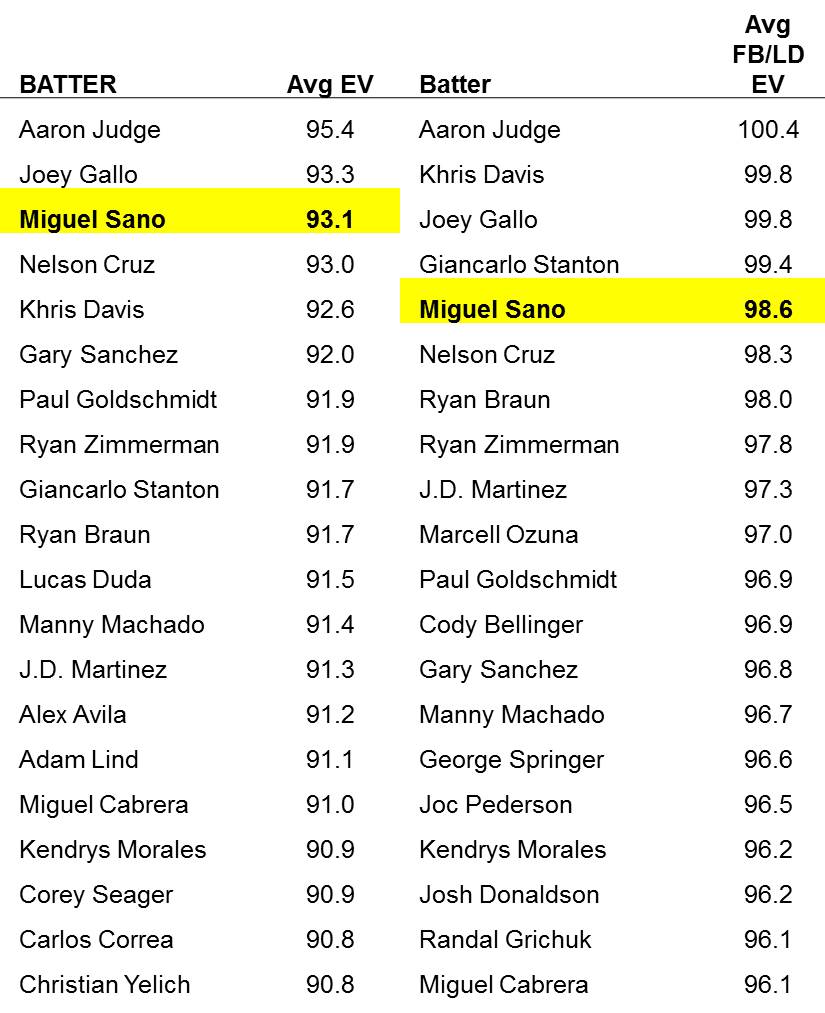
The 2016 and 2015 numbers tell much the same story, showing Sanó in baseball’s elite for average EV, both overall and on LD/FB. Not surprisingly, Sano is also among MLB leaders in the percentage of batted balls over 95 MPH, just below 50%. His average HR distance is 412 feet, comfortably out of most parks in most situations. And his percentage of batted balls classified as “barrels”—solid contact—is among the game’s top-10.
For all that, however, Sanó is actually not as prodigious a HR hitter as other players. Here are the top-20 batters based on HR/600 PA (HR600) since Sanó came up in 2015 (min 1,000 total PA):
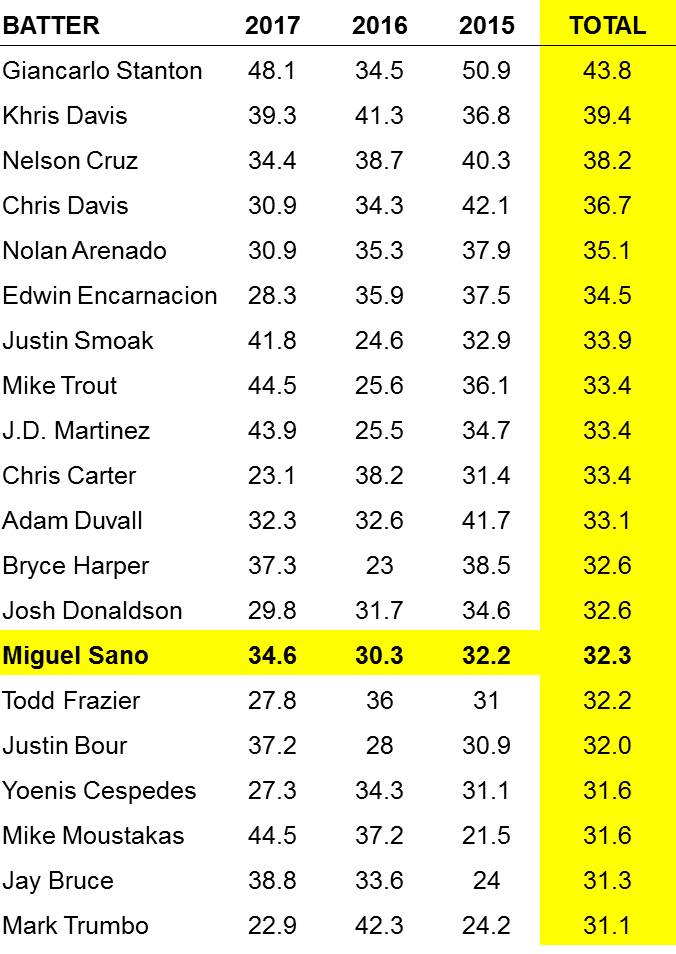
Decent company, although we see that Sanó has not yet climbed above the 35 HR600 level routinely achieved by baseball’s true HR elite. He also lags in RBI efficiency, trailing non-HR guys like Daniel Murphy and Correa and many of his HR-leader peers.
RBI/600 PA:
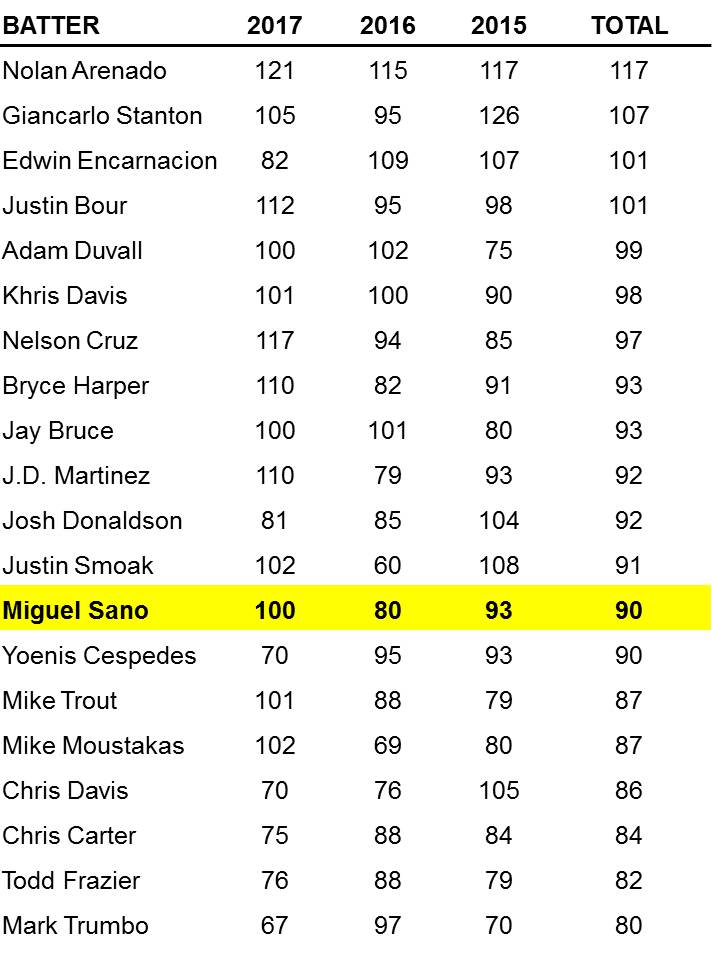
Part of that, of course, is the weak Twins lineup in which Sanó has been hitting. It’s hard to fault a guy for not driving in runners who aren’t on base. In 2015, MIN hitters had a .305 OBP (lower without Sanó). That inched up to .316 in 2016. And the Twins are all the way up to .330 this year, and Sanó’s RBIs are on pace for around 100 for the first time.
Overall, though, Sanó has taken his MLB career in a negative direction since his 2015 debut. BHQ’s Net Positive Outcomes metric totals a hitter’s positive outcomes (hard contact, line drives, walks and HBP) as a percentage of PA, then subtracts negative outcomes (Ks, weak- and medium-contact flies and grounders, and pop-ups), Sanó shows a net -16% in 2015, 10 points better than league average, but over the next two years he went backwards and is now actually slightly worse than average:

Z-Sw%: percent of pitches swung at in the strike zone
Z-Whiff%: percent of swing-and-misses within strike zone
O-Sw%: percent of pitches swung at outside the strike zone
O-Whiff%: percent of swing-and-misses outside strike zone
Whiff%: percent of swing-and-miss on all swings
SwStr%: percent of swing-and-miss on all pitches
The main culprits: consistently high strikeout rates across all three years, coupled with fewer walks and more weak contact. As we shall see, these outcomes can be properly ascribed to Sanó ‘s lack of discipline at the plate.
Analysis 2: Patience and Discernment
Some observers might be tempted to argue that the cost of Sanó–esque clout is often lots of whiffing. But even accepting that, Sanó stands out from his peers in the power elite, and not in a good way.
K/600 PA:
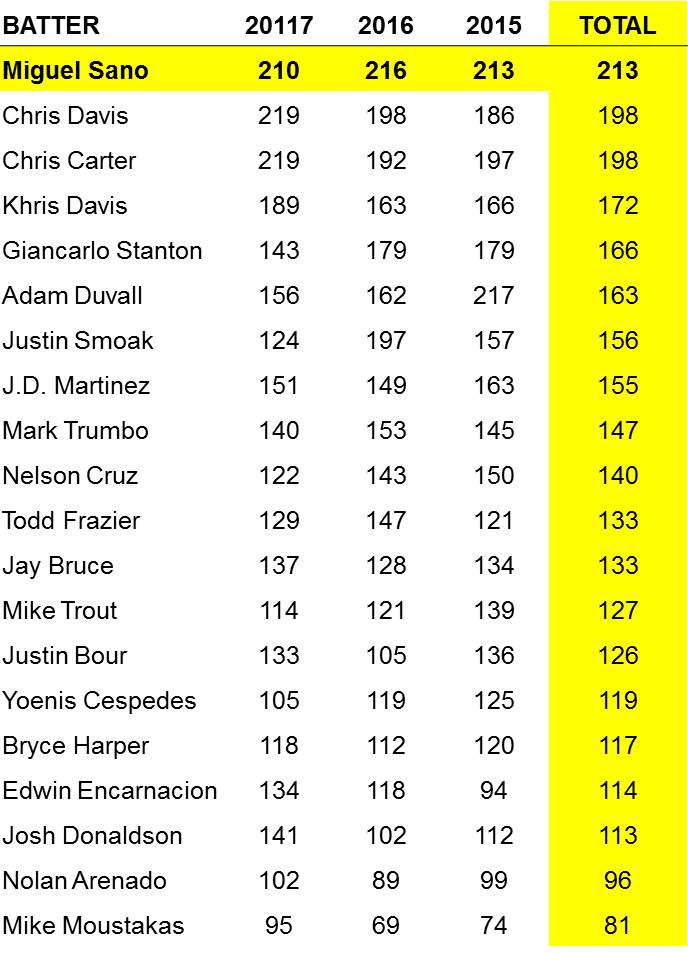
Note that this not a table of the overall leaders in K/600 PA, as it again excludes hitters with <1,000 PA in the period as well as some K-meisters who are not big HR guys, like Steven Souza, Michael Taylor, Randal Grichuk and many others.
The fact—and the central issue in trying to figure Sanó’s future path as an offensive fantasy producer— is that Sanó has struck out in more than one-third of his PAs. That leads to the linked questions of causes and potential fixes.
Sanó seems to have a decent eye for the strike zone. He takes a league-average number of walks—around 11% of his PA—and this plate-discipline table shows a hitter who has been at least somewhat choosy about his swings, especially at pitches out of the zone:

Zone%: percent of pitches seen in the strike zone
Sw%: percent of pitches swung at
Unfortunately, while Sanó has controlled the zone well, he has not shown much ability to control his swing, piling up whiffs at rates well above MLB norms. His overall whiff percentage is in the mid- to high-30 percents, 15 points above league average, and he is fooled too often outside the zone. In fact, he even whiffs a ton when he attacks pitches in the zone, missing a quarter of pitches he should be able to contact.
We can see visual evidence of Sanó’s aggressiveness out of the zone, especially low and away, in this graphic (compiled from BrooksBaseball.net):
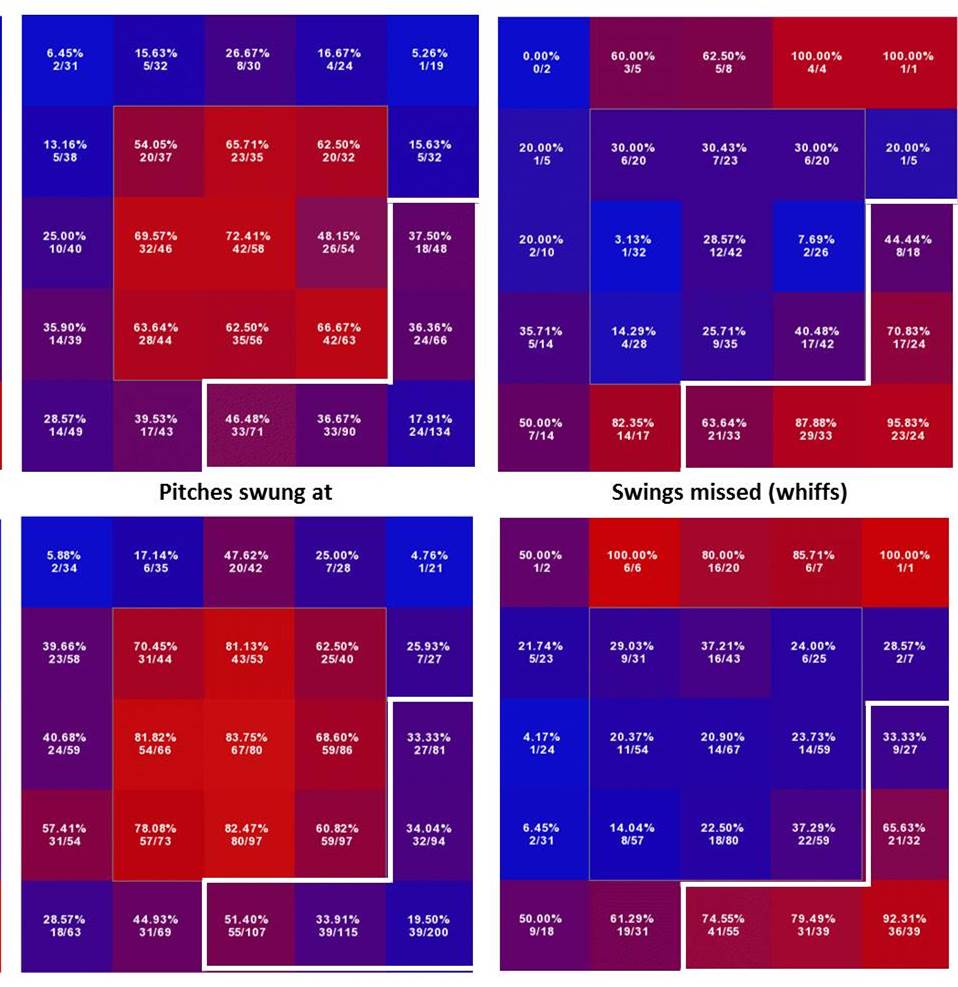
The small print will be tough to read, but here’s what the infographic tells us. It shows the strike zone in the middle nine boxes and outside the zone in the other 16. The top two maps are 2015, the bottom are 2017, and the view is from the catcher’s perspective, with the right-handed better on the left as you look at it.
In 2015, pitchers threw fully 34% of their offerings to Sanó in the area outside and low (outlined in white), particularly the far low-outside corner. He helped them by swinging at 32% of pitches in those areas—and whiffing on 74% of those swings. His BA on the rare occasions he put those balls into play was .124. This season, those swing and whiff percentages are almost exactly the same, but his BA is even worse, barely over .100. You might also notice the red boxes above the zone in both seasons—those are Sanó swinging-and-missing at almost every pitch up there.
Since both of these seasons are so similar, it might seem that Sanó is not applying his experience to his approach. In other words, he keeps making the same mistakes.
But there is a bit of evidence that Sanó can make adjustments. In 2016, from May through the all-star break, Sanó maintained a more modest swing rate while abruptly cutting way down on his whiffing, first to 32% and then to 29% (area between the green lines):
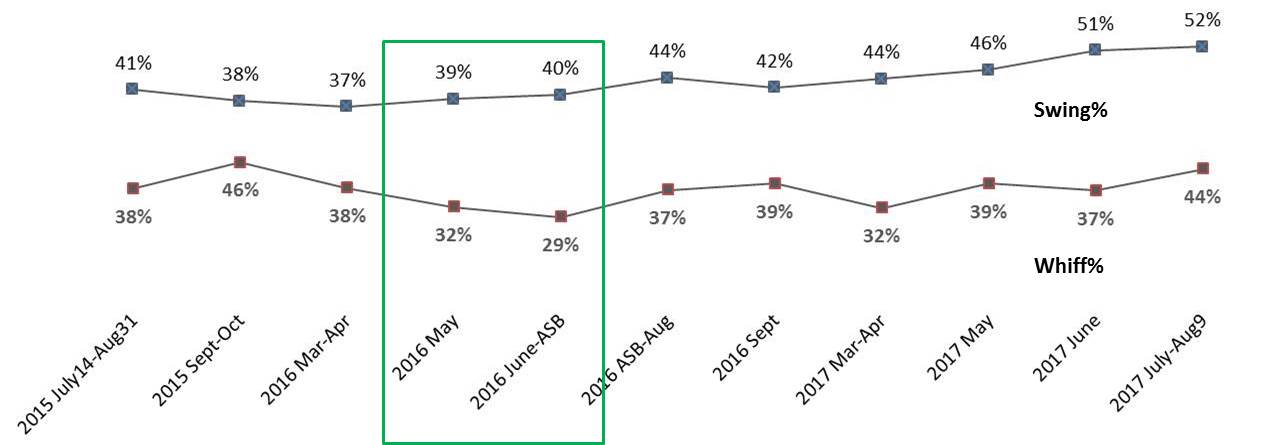
In particular, Sanó showed some discipline laying off sinkers and sliders, pitches that would have been be used to exploit his proclivity for whaling ineffectively at that stuff low and away:
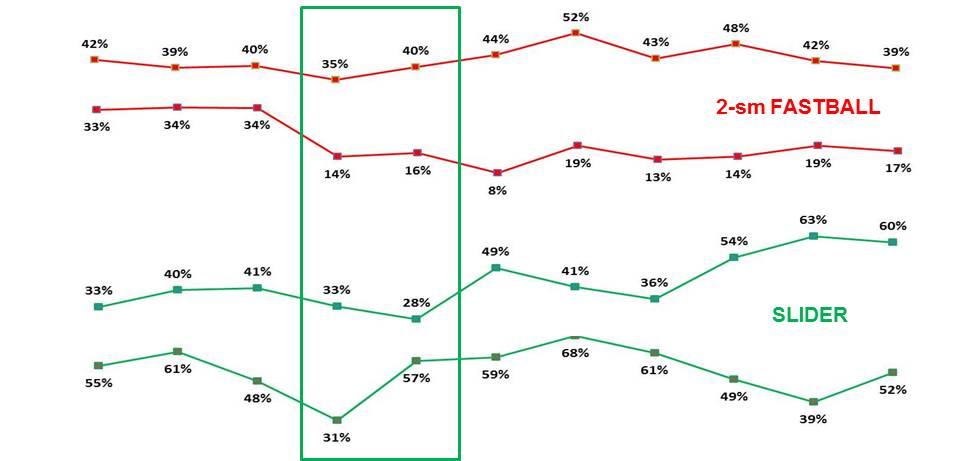
In both cases, the number of pitches is relatively small, so these might just be normal variation. But the benefits were obvious:
2016 bb% K% Slg HR600 ================================= May 1-ASB 13% 31% .526 42 Other 10% 38% .438 25
Unfortunately, as both infographics also show, Sanó either did not see or did not appreciate the greatly enhanced production that accompanied that burst of discipline, and hasn't been able to return to it, instead going back to his free-swinging, high-K ways.
Conclusion
None of this is to suggest that Miguel Sanó is a useless or even poor fantasy asset. Anybody who can reliably sock 30 HR will have a place on most teams. But thus far in his brief career, he has shown that his propensity to swing—and, especially, to miss—will put a fairly rigid limit on his upside. As a zero-speed guy, his fantasy value is already somewhat restricted, and as we’ve seen, his swing-and-miss will likely also cap the HR and RBI on which his future value will depend.
Of course, Sanó is only 24 years old (or so we’ve been led to believe). If that’s true, he has time to develop a more mature and disciplined approach. If he does, and if the Twins continue to develop decent OBP guys around him, he could easily become a consistent 40-HR, 110-RBI asset worth high-$20s, and if the discipline pays off in a higher BA (or in leagues playing OBP, where Sanó is already more of an asset), he could climb up to $30+. If he stays on the same course, however, he risks getting stuck in that $20 zone—a useful specialist, but one who will oblige owners to manage their rosters to correct for his production shortcomings, "handcuffing" Sanó to the Dee Gordon/Billy Hamilton/Jarrod Dyson types.
When Archbishop Fulton Sheen said the words that graced the start of this report, he also said something else that might be a prophecy for Miguel Sanó: “Patience is power.”
This might be an instance where we should pay attention to future spring training news, listening carefully for stories about Sanó’s “new approach” or similar stuff we usually dismiss as noise. If we do hear such things, the next step will be to watch that season’s camp carefully for signs that he is putting the words into practice. The upside is there. It's up to Sanó and the Twins to achieve it.



